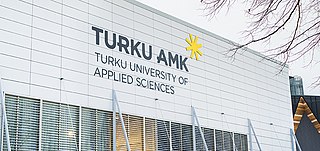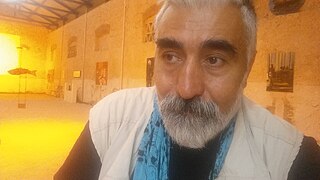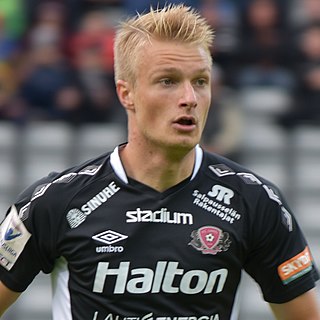
Turku is a city and former capital on the southwest coast of Finland at the mouth of the Aura River, in the region of Finland Proper (Varsinais-Suomi) and the former Turku and Pori Province. The region was originally called Suomi (Finland), which later became the name for the whole country. As of 31 March 2021, the population of Turku was 194,244 making it the sixth largest city in Finland after Helsinki, Espoo, Tampere, Vantaa and Oulu. There were 281,108 inhabitants living in the Turku Central Locality, ranking it as the third largest urban area in Finland after the Capital Region area and Tampere Central Locality. The city is officially bilingual as 5.2 percent of its population identify Swedish as a mother-tongue.

Mikael Agricola was a Finnish Lutheran clergyman who became the de facto founder of literary Finnish and a prominent proponent of the Protestant Reformation in Sweden, including Finland, which was a Swedish territory at the time. He is often called the "father of literary Finnish".

Raimo Heino was a Finnish designer of coins, relief figures and medallions.

Edvard Alexander Westermarck was a Finnish philosopher and sociologist. Among other subjects, he studied exogamy and the incest taboo.

Åbo Akademi University is the only exclusively Swedish language multi-faculty university in Finland. It is located mainly in Turku but has also activities in Vaasa. Åbo Akademi should not be confused with the Royal Academy of Åbo, which was founded in 1640, but moved to Helsinki after the Turku fire of 1827 and is today known as the University of Helsinki.

The University of Turku, located in Turku in southwestern Finland, is the third largest university in the country as measured by student enrollment, after the University of Helsinki and Tampere University. It was established in 1920 and also has facilities at Rauma, Pori, Kevo and Seili. The university is a member of the Coimbra Group.

Gatorade Center is a multi-functional indoor arena in the district of Artukainen in Turku, Finland. Opened in November 1990, it can hold up to 11,820 spectators for ice hockey games.

Turku Cathedral is the only medieval basilica in Finland and the Mother Church of the Evangelical Lutheran Church of Finland. It is the central church of the Lutheran Archdiocese of Turku and the seat of the Lutheran Archbishop of Finland, Tapio Luoma. It is also regarded as one of the major records of Finnish architectural history.
The Archdiocese of Turku, historically known as Archdiocese of Åbo, is the seat of the Archbishop of Turku. It is a part of the Evangelical Lutheran Church of Finland, and its see city is Turku.

Ralf Johan Gustaf Törngren was a Finnish politician, born in Oulu. He was the party leader of the Swedish People's Party (1945–1955), a member of the Finnish parliament and the Prime Minister of Finland 5 May – 20 October 1954. In the Finnish presidential elections of 1956, he won 20 electoral votes.

Turku University of Applied Sciences is a multidisciplinary higher education institution, located in the city of Turku and Salo in the Southwest Finland. The institute began operations as a temporary polytechnic in autumn 1992. Before 2006-01-10, the institution carried the English name of Turku Polytechnic.

Leena Estelle Luostarinen was a Finnish painter. Working as an artist for over forty years, she was well known for her colourful and mysterious works. Many of her paintings featured felines, ibises, flowers, and sphinxes.
Marjatta Tapiola is a Finnish painter. At the time of her breakthrough in the 1980s the neo-expressionist art style was gaining popularity; however Tapiola's art does not necessarily fit inside these boundaries. Some typical elements in Tapiola's paintings are minotaurs, horses and skulls. Tapiola's newer paintings are said to be characterized by fluent drawing quality and multilayered lines. Recent works often feature network of lines on a pale background.

Hasan Fuat Sari is a Finnish sculptor and painter. He was born in Tarsus into a Kurdish Family in 1953, and lives and works in Turku, Finland since 1980.

Mikko Kuningas is a Finnish professional footballer who plays as a midfielder or forward for USL Championship club Orange County SC.
SHIFT is a two-day international business festival held every year in Turku, Finland, at the Turku Castle. It was first held on May 31 and June 1, 2016. The attendees included over 1,000 visitors, 80 partner companies, 150 startups, and over 20 investors. Around 100 volunteers were part of this event. SHIFT 2017 is slated to be held on May 31 and June 1, 2017.

August Fredrik Ahlstedt was a Finnish landscape and portrait painter.

Nina Ahlstedt née Lingell (1853–1907) was a Finnish painter.

Elias Muukka was a Finnish painter. He mainly painted landscapes, usually from the rural areas of Karelia and from Turku.
The Tomten in Åbo Castle is a Finnish fairy tale from 1849 by Zachris Topelius. It tells the story of a friendship between an old tomten, who lived in Turku Castle for hundreds of years, and his only human friend. At the time of writing, the medieval Turku Castle, the site of events, was badly damaged, and the story had a major influence on the desire to restore this important landmark in the City of Turku.















